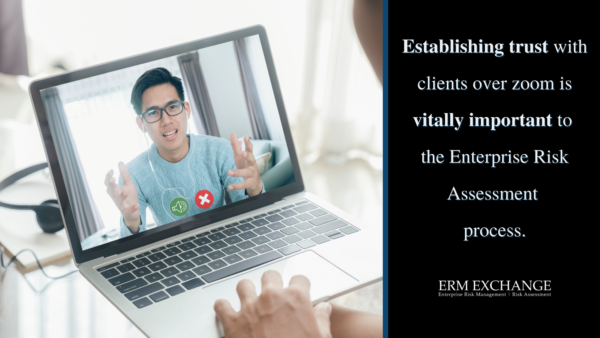
Honing the skills to perform insightful and action-able enterprise risk assessments have taken me years to perfect my craft. My skills were principally built upon one-on-one interviews with many fascinating individuals from all levels of management, from many different industries, and from many walks of life. Face to face, in the same room, breathing the same air.
Well, the pandemic changed that.
Remote working, labor shortages, inflationary pressures, and enhanced technologies like Zoom have created strange and new work routines. Inherently, video conferencing contributes to an intimacy deficit whereby eye contact and other non-verbal cues are more difficult to establish and identify through video conferencing.
By the way, “zoom” IS a four letter word.
The Importance of Establishing Trust with Clients
Perhaps the most important skill in the enterprise risk assessment process is establishing trust with clients. Why? Essentially, in the course of 60-90 minutes, the interviewer (in this case, me) must elicit insightful risks and mitigating actions from a relative stranger regarding sensitive issues which are always associated with business strategy, at times complicated, and often politically-charged.
Looking back, before the pandemic, establishing trust with clients while discussing risks was easy when in the same room with the interviewee. But trying to establish trust over Zoom is not the same. It’s harder. So, how do I create a trusting environment to facilitate the enterprise risk assessment process?
How to Establish Trust During the Enterprise Risk Assessment Process
Here are a few suggestions to establish a higher level of trust within the enterprise risk assessment process using your favorite video conferencing technology.
- Prepare & Show People You Care: to communicate effectively – read as much as you can to gain perspective on the individual, their job, their function and their company. Request background information well in advance including business plans, corporate initiatives, company overviews, investor presentations, recent consulting studies, press releases, corporate and departmental policies, financial and operational performance reports, and read each interviewee’s LinkedIn profile, and perhaps information related to their former employer. Ultimately, you want to close the information deficit between the interviewer and the interviewee as much as possible, so there is less time getting up-to-speed.
- Look at Your Interviewee, Not Yourself: No doubt, effectively communicating via Zoom requires a higher (and better) level of expression and engagement by both parties. Also, consider yourself ‘performing’ on Zoom calls yet avoid the temptation of looking at yourself. Rather, focus on the interviewee. Situate the interviewee on your screen as close to the camera as possible. And avoid having the interviewee appear on a different screen. As the interviewer, give the interviewee the clear impression “I am talking to you, and only you.” And invest the time and money to ensure great lighting on your face. Otherwise, the dark lighting can make an interviewer look somewhat sinister.
- Set the Stage for Candor: After describing your background and the purpose of the enterprise risk assessment process, clearly and openly explain to the interviewee that a successful interview requires a blunt and candid dialogue. Emphasize this can best be achieved when each interviewee remains anonymous. Sincerely explain to the interviewee that maintaining each individual’s anonymity is critical to the project’s success. Often, I hear “If I tell you this, they will know it came from me.” My response is always, “Communicating sensitive risks without revealing the sources is vital to my ongoing success and reputation. There are ways to express a risk or issue, without explicitly stating the most sensitive aspects of the issue.” Typically, most people understand this dynamic, and prefer to take advantage of the opportunity presented by the enterprise risk assessment process to communicate a pressing issue. It’s human nature – people generally want to help, as well as get heavy issues off their chest.
- Be Honest and Helpful: share what you’ve heard…anonymously of course. Share with the interviewee what you perceive – especially about sensitive topics – through your questions. For instance, ask “How challenging will it be to achieve double digit growth in each of the next three years with ‘Strategy A’?” And follow their answer with, “How would you change Strategy A?’ Often you will find the interviewee will respond in two ways by either clarifying or disagreeing with widely held perceptions by sharing their own views of certain acute risks and related strategies.
Enterprise Risk Assessment with ERM Exchange
John McLaughlin has spent his career working with sensitive information to better understand the risks facing an organization. His years of enterprise risk management interview experience directly translate to video conferencing, with a few key considerations. If you are having trouble getting honest and forthright opinions from all levels of your organization, contact ERM Exchange to learn about the enterprise risk assessment process from the expert.
